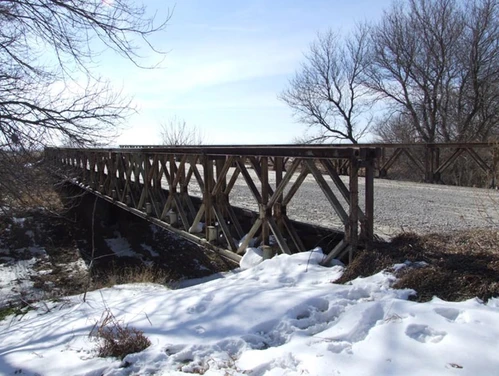- Year constructed: 1950
- Bridge type: Steel Double Panel "Bailey Bridge"
- National Register of Historic Places status: Eligible
- Length: 100 feet
- Width: 17.4 feet
- Spans: 1
- FHWA: 011290
- Jurisdiction: Fremont County Board of Supervisors
- Location: Level B Road/Thurman Corp. Line Road over Plum Creek in Thurman, Section 35, T70N-R43W (Scott Township)
Details
While no specific information could be found on the purchase of this bridge; in 1949, the Fremont County Board of Supervisors purchased "Bailey Bridge spans" from the Highway Bridge Company for $10,625.00 (Hamburg Reporter 1949:7). One year earlier, Mills County, to the north, purchased a Bailey Bridge to span Silver Creek (Council Bluffs Nonpareil 1948:12).
There are two additional Bailey bridges in the county (FHWA 6215 and 159460), one of which (6215) was installed in 2007 after a flood had washed away a bridge. A Bailey bridge is also used as an approach span to a pony truss northeast of Hamburg (FHWA 158970). All of the Bailey bridges in Fremont County are standard double trusses. Steel girders on 5' centers carry steel I-beams, over which 3’x6’ creosoted timber nailers support 3’x12’ creosoted timber plank decking. Categorized as Type 300 in the IaDOT's SI&A database, there appears to be only six Bailey bridges in the state including the three aforementioned bridges, one in Lucas County (FHWA 226860), one in Jefferson County (FHWA 201610), and one in Buchanan County (FHWA 81500).
The British Bailey Bridge was invented by Donald Bailey, a British engineer, to withstand the heavier 40ton tank. His design was adopted by the US military at the outset of World War II (M1 in US nomenclature). They were desirable for their ease of transportation and rapid set-up in wartime situations. No specialized equipment was needed, and all of the parts needed for a Bailey could be moved by 5-ton dump trucks and trailers. Standardized designs and modular components meant that span lengths could be adapted to each location. After the war, Bailey bridges were sold as surplus as well as distributed through the Federal Works Agency as part of their disaster relief program (Council Bluffs Nonpareil 1947:1). Several Bailey bridges were sent to Iowa as there had been extreme flooding in the summer of 1946 that had washed out many bridges.
The Thurman Bailey bridge meets several registration requirements outlined in the MPD, Highway Bridges in Iowa: 1942-1970 and as such is eligible for inclusion in the NRHP under Criterion C. The bridge is a rare survivor of the Bailey bridge type that was used after WWII by several municipalities across the state to replace flood ravaged bridges or as an economical solution for a new crossing. The bridge is also a specialized design of recognized importance for its ease of construction and adaptability to many different situations. The bridge has a high degree of integrity with only minor repairs to the wood deck being completed in 2004.
Areas Served
- Fremont
